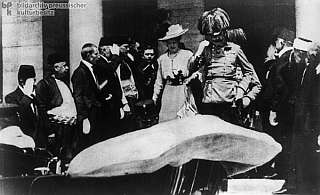
Franz Ferdinand and his wife Sophie leave the Sarajevo Town Hall on 28 June 1914, five minutes before the assassination.
The Good Soldier Švejk is a novel with an unusually rich array of characters. In addition to the many who directly form part of the plot, a large number of fictional and real people (and animals) are mentioned; either through the narrative, Švejk's anecdotes, or indirectly through words and expressions.
This web page contains short write-ups on the people that the novel refers to; from Napoléon in the introduction to Hauptmann Ságner in the last few lines of the unfinished Part Four. The list is sorted in the order of which the names first appear. The chapter headlines are from Zenny Sadlon's recent translation (1999-2024) and will in most cases differ from Cecil Parrott's version from 1973.
The quotes in Czech are copied from the on-line version of The Good Soldier Švejk: provided by Jaroslav Šerák and contain links to the relevant chapter. The toolbar has links for direct access to Wikipedia, Google maps, Google search, svejkmuseum.cz and the novel on-line.
The names are coloured according to their role in the novel, illustrated by the following examples:
- Dr. Grünstein as a fictional character who is directly involved in the plot.
- Fähnrich Dauerling as a fictional character who is not part of the plot.
- Heinrich Heine as a historical person.
Note that a number of seemingly fictional characters are inspired by living persons. Examples are Oberleutnant Lukáš, Major Wenzl and many others. This are still listed as fictional because they are literary creations that are only partly inspired by their like-sounding "models".
Military ranks and some other titles related to Austrian officialdom are given in German, and in line with the terms used at the time (explanations in English are provided as tooltips). This means that Captain Ságner is still referred to as Hauptmann although the term is now obsolete, having been replaced by Kapitän. Civilian titles denoting profession etc. are translated into English. This also goes for ranks in the nobility, at least where a direct translation exists.
 People index of people, mythical figures, animals ... (588)
Show all
People index of people, mythical figures, animals ... (588)
Show all I. In the rear
I. In the rear  1. The good soldier Švejk acts to intervene in the world war (30)
1. The good soldier Švejk acts to intervene in the world war (30) 14. Švejk as military servant to senior lieutenant Lukáš (35)
14. Švejk as military servant to senior lieutenant Lukáš (35) II. At the front
II. At the front  1. Švejk's mishaps on the train (22)
1. Švejk's mishaps on the train (22) 2. Švejk's budějovická anabasis (55)
2. Švejk's budějovická anabasis (55) 3. Švejk's happenings in Királyhida (46)
3. Švejk's happenings in Királyhida (46) 5. From Bruck on the Leitha toward Sokal (45)
5. From Bruck on the Leitha toward Sokal (45) III. The famous thrashing
III. The famous thrashing  1. Across Magyaria (52)
1. Across Magyaria (52) 2. In Budapest (32)
2. In Budapest (32) 3. From Hatvan to the borders of Galicia (31)
3. From Hatvan to the borders of Galicia (31) 4. Forward March! (32)
4. Forward March! (32) IV. The famous thrashing continued
IV. The famous thrashing continued  1. Švejk in the transport of russian prisoners of war (35)
1. Švejk in the transport of russian prisoners of war (35) 3. Švejk again with his march company (20)
3. Švejk again with his march company (20)



|
II. At the front |
 | |
1. Švejk's mishaps on the train | |||
 | Nechleba |  | ||||
| ||||||
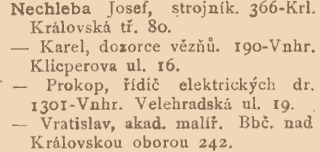
, 1910
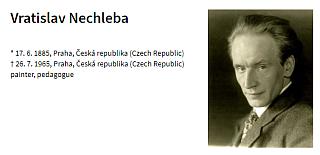
Nechleba from Nekázanka is mentioned by Švejk when he is explaining to Oberleutnant Lukáš that he tries to do good but rarely succeeds. Nechleba suffered from the same bad luck.
Background
Nechleba was a rare name in Prague in 1910. Only three of them are listed in the address book and none of them in Nekázanka.
Vratislav Nechleba (1885-1965) was a well-known painter who Hašek probably knew or at least knew about. Still it is quite far fetched to suggest that the author borrowed his name.
Quote(s) from the novel
[II.1] „Poslušně hlásím, že jsem to, pane obrlajtnant, pozoroval. Já má, jak se říká, vyvinutej pozorovací talent, když už je pozdě a něco se stane nepříjemnýho. Já mám takovou smůlu jako nějakej Nechleba z Nekázanky, který tam chodil do hospody ,V čubčím háji’.
 | Mr. Purkrábek |  | ||||
| ||||||

, 15.9.1934
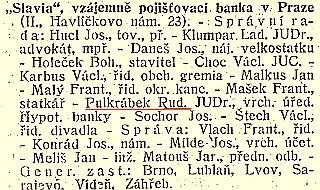
,1912
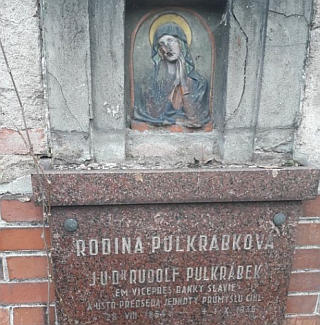
Pulkrábek's grave at Olšany cemetery.
© Daniel Soukup
Purkrábek enters the plot as Švejk mistakenly thinks the bald passenger sitting opposite him is Purkrábek, a representative of Banka Slavia. Not to be confused with Landwehrsoldat Purkrábek.
Background
Purkrábek was a common surname in Prague at the time, but address books do not reveal anyone that can be associated with the banking or insurance sectors.
Knesl
Augustin Knesl claims that some Jaroslav Purkrábek worked together with Hašek in Banka Slavia the short period he was employed there in 1902-1903[a]. It has not been possible to gather information about this person and he is not entered in the police registers or in the address books. Knesl does not provide any source and also tries to fit reality to the content of the novel. Thus he concludes that Purkrábek later entered the army and later appeared in The Good Soldier Švejk for the second time!
Rudolf Pulkrábek
The author was rather inspired by Rudolf Pulkrábek, a Czech banker and industrialist born in Frydland 28 August 1864[b]. He took over the brickworks (cihelna) at Vokovice after the death of his father in 1882.
In 1912 he is listed as a member of the board of Banka Slavia, but he was better known as an executive of Hypoteční Banka where he had spent 25 years by 1914. Pulkrábek was re-elected as a board member in 1916 and in 1923 he had become managing director. In connection with his 70th birthday in 1934 a picture of him appeared in Salon. The sub-title reveals that he now held the position of vice president. Pulkrábek died on 1 October 1936 and is buried at Olšany cemetery.
Jaroslav Hašek is likely to have known him from his brief employment at this bank in 1902 and 1903 or he might also have heard of him from his brother Bohuslav who was employed in the bank for his entire working career. Still there are marked differences between Pulkrábek and the bald literary figure. The former was in a position far above the ordinary representative and the photo from 1934 reveals that Pulkrábek was not entirely bald.
Names partly interchanged
The reader may also object that Pulkrábek and Purkrábek are not identical names. This is true but the two are phonetically and lexically very close and were at times even interchanged. Examples of this can be found in Čech and Pilsner Tagblatt[c].
Quote(s) from the novel
[II.1] „Dovolte, vašnosti, neráčíte být pan Purkrábek, zástupce banky Slavie?“ Když holohlavý pán neodpovídal, řekl Švejk nadporučíkovi: „Poslušně hlásím, pane obrlajtnant, že jsem jednou četl v novinách, že normální člověk má mít na hlavě průměrně šedesát až sedumdesát tisíc vlasů a že černý vlasy bývají řidčí, jak je vidět z mnoha případů.“
[II.1] Von vopravdu je celej pan Purkrábek, zástupce banky Slavie. Ten chodil k nám do hospody a jednou, když u stolu usnul, tak mu na jeho pleš nějakej dobrodinec napsal inkoustovou tužkou:
Dovolujeme si vám tímto dle připojené sazby III. c) zdvořile nabídnouti nastřádání věna a vybavení vašich dítek pomocí životního pojištění!
Credit: Augustin Knesl, Daniel Soukup, Milan Šedivý, Sergey Soloukh
Literature
- Pobytové přihlášky pražského policejního ředitelství, ,1851 - 1914
- Josef Švejk a ti druzí, Augustin Knesl [a]
- Osobní, ,19.3.1908
- Volkswirtschaftliches, ,4.8.1912 [c]
- Padesáté narozeniny, ,28.8.1914 [b]
- "Slavie", ,20.5.1916
- "Hubertus", továrna na výrobu zbraní a obchodní závody, akc. spol., ,17.2.1923
| a | Josef Švejk a ti druzí | Augustin Knesl | |
| b | Padesáté narozeniny | 28.8.1914 | |
| c | Volkswirtschaftliches | 4.8.1912 |
 | Generalmajor von Schwarzburg |  | ||||
| ||||||
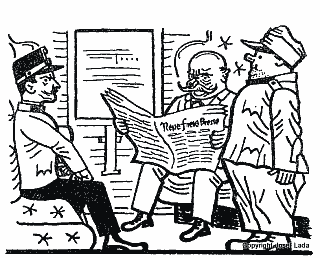

,14.5.1914

,17.3.1915

,2.6.1915

,4.6.1915
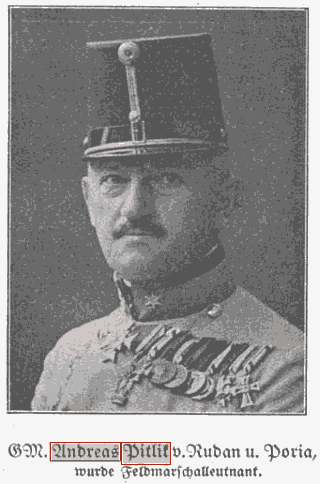
,17.5.1914
Von Schwarzburg enters the plot as Švejk mistakenly thinks the passenger opposite him is Purkrábek, a representative of Banka Slavia. Instead it turns out to be Generalmajor von Schwarzburg, a terrifying army inspector who is on his way to surprise the garrison in Budějovice. This episode was obviously very unpleasant for Oberleutnant Lukáš.
Background
No von Schwarzburg can not be found in military records but army inspectors did of course exist. Those were higher ranking senior officers. Responsible for the garrison in Budějovice was k.u.k. Militärkommando Prag so army inspectors would be based there. At least two high ranking officers are known to have inspected Budějovice during or around the time that Jaroslav Hašek served there (17 February to 1 June 1915). They both held the rank Feldmarschall-Leutnant and were assigned to the 8th army corps (Prague).
Schwerdtner von Schwertburg
The most obvious inspiration for the bald and elderly gentleman on the train is Simon Ritter Schwerdtner von Schwertburg (1854-1925). The nobility suffix von Schwertburg is close enough to von Schwarzburg and within the author's margin of error with regard to spelling.
Schwerdtner was at the time commander of the Prague garrison to which he had been transferred from Olomouc in May 1914. His rank was Feldmarschall-Leutnant and he was promoted from Generalmajor on 1 May 1912. In Olomouc he served as commander of 5. Infanteriedivision from 2 May 1912.
He visited Budějovice for inspection purposes at least twice when Hašek served there and had also been there at least twice in the autumn of 1914. The dates of arrival were 13 April and 31 May 1915. He was present when Ersatzbataillon IR. 91 in two stages was transferred to Királyhida (1 June). That Jaroslav Hašek knew about Schwerdtner and his role is inevitable and he was surely present during at least one of the inspections.
The officer was known as a German chauvinist with a dislike for Czechs and was the driving force behind the execution of reservist Kudrna in 1915. He was personally present at Motolské cvičiště when the soldier from IR102 was executed. Schwerdtner claimed it was necessary to make an example to deter disloyal elements. He was known as a hard-liner on nationality issues and pushed hard for the arrest of Kramář and Scheiner i 1915. In 1913 in Olomouc he was the driving force behind a summary trial and following execution of the corporal Jan Bagacz who had shot senior lieutenant Rudolf Schramek during manoeuvres.
Pitlik von Rudan und Poria
The second high-ranking inspector based in Prague was Andreas Pitlik von Rudan und Poria (1856-1937) (cz. Ondřej Radko Pytlík) who is known to have inspected the garrison in Budějovice in January, March and June 1915. Some newspapers reported briefly on the inspections and they also revealed that he stayed at Hotel Grand opposite the railway station.
Born in Plzeň he started his career in his native Infanterieregiment Nr. 35 and later served in numerous units, amongst them IR53 in Zagreb where he was promoted to major in 1898. At this time the 42 year old officer was also named Flügeladjutant for His Imperial Majesty. In December 1899 he had already become an Oberstleutnant. In 1906 his rank was Oberst and that year he was transferred to IR56 as the regiment's commander. In 1908 he was knighted with the noble suffix von Rudan und Poria.
At the outbreak of war in 1914 Pitlik was commander of the 24. Infanteriedivision in Przemyśl. He had been promoted from Generalmajor on 1 May 1914 but already in the autumn he requested and was granted a six month leave for health reasons. After a spa break he returned to service and from now on he served at k.u.k. Militärkommando Prag. From around 1 June 1915 he was formally in charge of training of the reserves in military district No. 8 (Prague, south and west Bohemia), the schools for one year volunteers, and recuperation hospitals.
Quote(s) from the novel
[II.1] A nyní se stalo něco hrozného. Holohlavý pán vyskočil, zařval na něho: „Marsch heraus, Sie Schweinkerl,“ vykopl ho do chodby, a vrátiv se do kupé, uchystal malé překvapení nadporučíkovi tím, že se mu představil. Byl to nepatrný omyl. Holohlavé individuum nebylo panem Purkrábkem, zástupcem banky „Slavie“, ale pouze generálmajorem von Schwarzburg. Generálmajor konal právě v civilu inspekční cestu po posádkách a jel překvapit Budějovice.
Literature
- Ein neuer Flügeladjutant Sr. Majestät, ,23.4.1898
- Herr Andreas Pitlik, ,1900
- Der Mörder des Oberleutnants Schramek vor dem Standrechte, ,27.3.1913
- Adelsverleihung, ,28.3.1908
- Vojenská inspekce, ,13.1.1915
- Militärkommandant FML. Ritter von Schwerdtner, ,14.4.1915
- Vojenská inspekce, ,2.6.1915
- Millitärpersonalnachrichten, ,2.6.1915
- Vojenská inspekce, ,9.6.1915
- Verordnungsblatt Nr. 5 für das Heer, ,8.1.1916
- Jak to bylo za válkou, ,1.6.1929
- Připad Josefa Kudrny, ,12.7.1932
- Hašek narukuje, Antonín Bouček,23.3.1947
- Andreas (Ondrej) Pitlik, 1856 - 1937,
- Simon Ritter Schwerdtner von Schwertburg,
- Der Oberste Kriegsherr und sein Stab, ,1908
 | Tailor Hývl |  | ||||
| ||||||
Hývl was a tailor who was mentioned in an anecdote that Švejk tell Oberleutnant Lukáš to execuse his thinking aloud in front of Schwarzburg. He was unlucky with some utterances in his native Czech after assuming that the passenger Vojtěch Rous who was sitting opposite him wouldn't understand him. This happened on the train route Maribor - Leoben - Prague, by Sankt Moritz. The tailor was one the way home from a job in Styria.
Background
Any real person who might have served as inspiration for this literary tailor has not been possible to identify. In the 1910 Prague addess book there are only two Hývl's listed so it was obviously a rare surname. None of them were tailors (one cooper and one butcher). In army records the name is equally rare. Only two appear in Austro-Hungarian World War I casualty lists and one joined České legie. None of them served in the same units as Hašek so the name is hardly inspired by the author's time in IR. 91.
Quote(s) from the novel
[II.1] To nám jednou před léty vypravoval krejčí Hývl, jak jel z místa, kde krejčoval ve Štyrsku, do Prahy přes Leoben a měl s sebou šunku, kterou si koupil v Mariboru. Jak tak jede ve vlaku, myslel si, že je vůbec jedinej Čech mezi pasažírama, a když si u Svatýho Mořice začal ukrajovat z tý celý šunky, tak ten pán, co seděl naproti, počal dělat na tu šunku zamilovaný voči a sliny mu začaly téct z huby. Když to viděl krejčí Hývl, povídal si k sobě nahlas: ,To bys žral, ty chlape mizerná.’
 | Rous, Vojtěch |  | ||||
| ||||||

, 6.12.1915
Vojtěch Rous was the fellow passenger of the tailor Hývl in the anecdote told by Švejk to illustrate how one could be unlucky when thinking others don't understand ones own language. Švejk told this story on the train just before Tábor.
Background
In the Infanterieregiment Nr. 91 Verlustliste from the battle of Chorupan 24 September 1915[a] a soldier Adalbert Raus[1] from Budweis is listed as prisoner of war. This was actually the very battle where Jaroslav Hašek himself was captured. Both would thus have been part of the transfer on foot from the battle field by Dubno to the transit camp in Darnytsa, around 350 km.
If they didn't know each other already they may well have done so during the three weeks the march lasted. That said: even if Hašek knew Raus there is surely not more to it than name-borrowing.
1. Adalbert is the German variation of Vojtěch.
A brutal murder
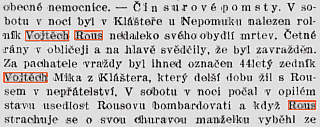
, 21.9.1907
Another person who may have inspired the name was a farmer from Klášter by Nepomuk who was brutally murdered on 14 September 1907. The killer was his neighbour Vojtěch Mika who was eventually found guilty and sentenced to death. Jaroslav Hašek was an avid newspaper reader with an excellent memory of detail so he may perhaps have come across the news story and remembered it.
Quote(s) from the novel
[II.1] Když to viděl krejčí Hývl, povídal si k sobě nahlas: ,To bys žral, ty chlape mizerná.’ A ten pán mu česky vodpoví: ,To se ví, že bych žral, kdybys mně dal.’ Tak tu šunku sežrali společně, než přijeli do Budějovic. Ten pán se jmenoval Vojtěch Rous.“
Credit: Jan Ciglbauer
Literature
- The battle of Chorupan, ,2021 [a]
- Mord, ,20.9.1907
- Todesurteil, ,29.11.1907
- Odsouzen k smrti provazem, ,4.12.1907
| a | The battle of Chorupan | 2021 |
 | Hofmann |  | ||||
| ||||||
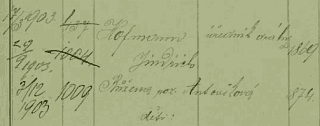
Jindřich Hofmann, Žižkov
Národní archiv, , konskripce
Hofmann was mentioned in a conversation between Švejk and the attendant on the train between Prague and Tábor. Hofmann had claimed that emergency brakes do not work. This conversation led to the incident where Švejk was accused of having stopped the train.
Background
It has not possible to identify any real-life inspiration for Hofmann. This surname (or variations on it) was quite common, but without information like occupation, domicile etc. he is likelely to remain unidentified. In Prague there were several people with the surname Hofmann but none of them stands out as someone that Hašek would have been likely to associate with.
We may speculate that this anecdote was picked up in a pub. The author probably still lived in Žižkov when he wrote these passages and people from here are mentioned a few paragraphs later (Franta Šnor and Policejní rada Kraus). If it is the case that the name Hofmann originates from the author's near surroundings it is of interest to note that two persons with this surname lived in Žižkov before World War I and probably also after. Amongst them were Bohuslav Hofmann and Jindřich Hofmann.
In Infanterieregiment Nr. 91 a Zugsführer Karl Hofmann from Krumlov served and he was captured by Chorupan together with Hašek on 24 September 1915[a]. It is possible that the author knew this person, but even if he did it would at most have inspired him to borrow the surname.
Quote(s) from the novel
[II.1] „Ke mně chodíval,“ rozhovořil se Švejk, „jeden dobrej člověk, nějakej Hofmann, a ten vždy tvrdil, že tyhle poplašný signály nikdy neúčinkují, že to zkrátka a dobře nefunguje, když se zatáhne za tuhle rukojeť.
Literature
- The battle of Chorupan, ,2021 [a]
| a | The battle of Chorupan | 2021 |
 | Šnor, František |  | ||||
| ||||||
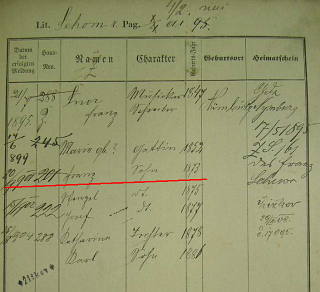
Franz Šnor, Žižkov
Národní archiv, , konskripce
Franta Šnor was mentioned in an anecdote by Švejk because he had kneeled before the carriage of Emperor Franz Joseph I. when His Majesty visited Žižkov. He was fined 20 crowns, just like Švejk on the train to Tábor.
Background
František Šnor was the name of two men in Žižkov at the time in question. The youngest of them had a son Karel and it is possibly this Karel who was landlord at U kamenáče when Jaroslav Hašek wrote the first part of the novel during the spring of 1921. It is typical of the author to "re-use" names of real people in this manner. The imperial visit in question was probably that of 1907, but the emperor also visited Žižkov in 1901. See starý Procházka.
Jaroslav Šerák
V Praze moc Šnorů nežilo, pouze dvě rodiny, ale na Žižkově žila skutečně jedna rodina Šnorů: Otec František *1847 a byl písařem (officiant, Schreiber), měl syna Františka * 1873.Jeden z těchto Františků si mohl kleknout před kočár. Dále zde byl syn Karel * 1886 – ten mohl být tím hostinským „U kamenáče“.
Quote(s) from the novel
[II.1] Jednou, když byl císař pán návštěvou na Žižkově, tak nějakej Franta Šnor zastavil jeho kočár tím, že si před císařem pánem kleknul na kolena do jízdní dráhy.
Credit: Jaroslav Šerák
 | Policejní rada Kraus |  | ||||
| ||||||
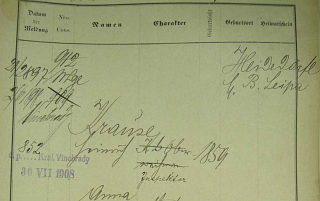
Heinrich Krause, Královské Vinohrady
Národní archiv, , konskripce
Kraus was a police chief who is mentioned in the same anecdote as Franta Šnor.
Background
The person referred seems to be inspired by police inspector Heinrich Krause. He was borned 11 February 1859, lived in Vinohrady in 1908 and then in Lupačova ul. 12 in Žižkov in 1910. He was married with three children.
Jaroslav Šerák
Jméno Kraus se adresáři nevyskytuje, ale je tam inspektor jménem Jindřich [Heinrich] Krause. Zachovala se i policejní pobytová přihláška, kde je uveden v roce 1908 jako inspektor, bytem Vinohrady, č.p. 852.
Quote(s) from the novel
[II.1] Potom ten policejní komisař z toho rayonu řekl k panu Šnorovi s pláčem, že mu to neměl dělat v jeho rayonu, že to měl udělat vo jednu ulici níž, co patří už pod policejního radu Krause, tam že měl vzdávat hold. Potom toho pana Šnora zavřeli.“
Credit: Jaroslav Šerák
Literature
 | Mlíčko, František |  | ||||
| ||||||
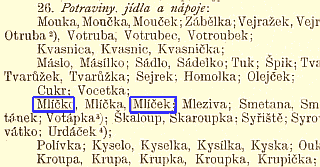
, 1894
Mlíčko František is mentioned in an anecdote told by Švejk on the train to Budějovice because he also had stopped a train by pulling the emergency brake. He was from Uhříněves by Prague and the incident had happened in May 1912.
Background
Any real life person who may have served as inspiration for this Mlíčko (or Mlíček) has not been identified. This despite that the place Uhříněves and the year of 1912 may provide clues. Jaroslav Šerák has even investigated the birth records of Uhříněves from 1876 to 1919 without finding any of these family names.
Mlíčko or Mlíček?
Because Švejk here uses the accusative form Mlíčka both Mlíčko and Mlíček are possible in the nominative case. Translators and švejkologists largely agree that Mlíčko is the correct name but Jaroslav Šerák keeps the alternative open.
Although the ambiguity can't be fully resolved, investigations of address books, name databases and searches in historical newspapers strongly indicate that Mlíčko was the intended surname. In Prague not a single Mlíček was entered in the address books (1907, 1910) and in 2021 no Mlíček lived in the Czech Republic at all[a]. Mlíčko is also very rare but at least it is recorded (35 persons in 2021). See also bricklayer Mlíčko and carpenter Mlíčko.
Quote(s) from the novel
[II.1] Poněvadž železniční zřízenec neodpovídal, prohlásil Švejk, že znal nějakého Mlíčka Františka z Uhříněvse u Prahy, který také jednou zatáhl za takovou poplašnou brzdu a tak se lekl, že ztratil na čtrnáct dní řeč a nabyl ji opět, když přišel k Vaňkovi zahradníkovi do Hostivaře na návštěvu a popral se tam a voni vo něho přerazili bejkovec. „To se stalo,“ dodal Švejk, „v roce 1912 v květnu.“
Credit: Jaroslav Šerák
Literature
- Příjmení: 'Mlíčko', počet výskytů v celé ČR, ,2017 [a]
- Naše příjmení, ,1894
| a | Příjmení: 'Mlíčko', počet výskytů v celé ČR | 2017 |
 | Gardener Vaněk |  | ||||
| ||||||
Vaněk was a gardener from Hostivař who is mentioned in the same anecdote as Mlíčko František.
Background
Any real life person who may have served as inspiration has not been possible to identify.
Quote(s) from the novel
[II.1] Poněvadž železniční zřízenec neodpovídal, prohlásil Švejk, že znal nějakého Mlíčka Františka z Uhříněvse u Prahy, který také jednou zatáhl za takovou poplašnou brzdu a tak se lekl, že ztratil na čtrnáct dní řeč a nabyl ji opět, když přišel k Vaňkovi zahradníkovi do Hostivaře na návštěvu a popral se tam a voni vo něho přerazili bejkovec. „To se stalo,“ dodal Švejk, „v roce 1912 v květnu.“
 | Station master Wagner |  | ||||
| ||||||
Wagner was a cruel station master in Svitava, mentioned in one of the many anecdotes Švejk reels off on the train journey to Tábor.
Background
Wagner was a very common surname so the author may have borrowed the name anywhere. In Infanterieregiment Nr. 91 there were several of them and no less than seven were reported missing at Chorupan together with Hašek after the battle on 24 September 1915[a]. Whether or not Hašek knew them or met them is pure speculation.
Quote(s) from the novel
[II.1] Švejk vytáhl z bluzy dýmku, zapálil si, a vypouštěje ostrý dým vojenského tabáku, pokračoval: „Před léty byl ve Svitavě přednostou stanice pan Wagner. Ten byl ras na svý podřízený a tejral je, kde moh, a nejvíc si zalez na nějakýho vejhybkáře Jungwirta, až ten chudák se ze zoufalství šel utopit do řeky.
Literature
- The battle of Chorupan, ,2021 [a]
| a | The battle of Chorupan | 2021 |
 | Switch operator Jungwirt |  | ||||
| ||||||
Jungwirt was a railway switch operator in Svitava, mentioned in the same anecdote as station master Wagner. He was persecuted by his boss Wagner and drowned himself in the river in desperation. Still he returned to haunt the latter who in turn hanged himself from a signal post.
Background
Jungwirt or Jungwirth was a quite common surname so the author may have borrowed the name anywhere. In Infanterieregiment Nr. 91 there were several of them and three were reported missing at Chorupan together with Hašek after the battle on 24 September 1915[a]. One of them was a Gefreiter, the other two ordinary infantrymen. Whether or not Hašek knew them or met them is pure speculation. In Prague lived tens of people with the surnames Jungwirth/Jungwirt/Jungvirt.
Quote(s) from the novel
[II.1] Švejk vytáhl z bluzy dýmku, zapálil si, a vypouštěje ostrý dým vojenského tabáku, pokračoval: „Před léty byl ve Svitavě přednostou stanice pan Wagner. Ten byl ras na svý podřízený a tejral je, kde moh, a nejvíc si zalez na nějakýho vejhybkáře Jungwirta, až ten chudák se ze zoufalství šel utopit do řeky.
Literature
- The battle of Chorupan, ,2021 [a]
| a | The battle of Chorupan | 2021 |
 | Brewer Zeman, Josef |  | ||||
| ||||||


,21.1.1911

© Jan Profous

,15.12.1889

, s. 186
Zeman was according to the novel a brew-master in Zdolbunov, mentioned in a conversation between Švejk and his benefactor at Tábor railway station. The latter asks the soldier to pass his greetings to the brewer Zeman. In this conversation Švejk is encouraged to defect as soon as he gets to the front, something he strongly indicates that he intends to do.
Background
Zeman most probably refers to the successor of Josef Zeman (1848-1892) who in 1880 founded a brewery in Kvasilov (ukr. Kvasyliv), a Czech settlement a few kilometres north of Zdolbunovo.
Kvasilov
The Polish site Polskie etykiety z piwa do 1945 r (now defunct) however reveals that the Kvasilov brewery in the inter-war period was owned by a Josef Zeman, born in 1873. A newspaper note from 1889 refers to Josef Zeman the elder, Josef Zeman the younger and Václav Zeman as brewers in Kvasilov in Russland[a].
Newspaper adverts from 1897 and 1900 in Der Böhmische Bierbrauer reveal that the owner of the brewery in Kvasilov was Anna Zemanová[b], presumably the widow of Josef Zeman Sr., the founder of the brewery who died in 1892. Adverts from 1911 to 1913 reveals that J. Zeman owned it. The brewery even owned a railway carriage[c].
Švec meeting Zeman
Josef Jiři Švec notes in his diary that he met the brewer Zeman in the summer of 1915. Švec describes him as a tall and vivacious man, married to an interesting brown-haired lady. His brother was, like Švec, a member of Česká družina, a force of Czech volunteers who would later develop into the Czechoslovak army in Russia, after the war known as the Legions.
Brewery in Lutsk
Another Zeman brewery was much better known. In 1888 Václav Zeman set up his own operation in Lutsk, and it was ultimately very successful. It was therefore logical to assume that Josef Zeman was sole proprietor in Kvasilov after this, and that it is him Jaroslav Hašek refers to in the novel.
History - before and after
The Zeman family had immigrated to Volhynia from Bohemia in 1870, and the father of Václav; Josef, was also a brewer. In Lutsk the Zeman brewery operated until the plant was nationalised after the Soviet invasion of Poland in September 1939. In 1940 the family were deported to Siberia, but Václav Zeman never lived to experience this tragedy. In 2003 a brewery named Zeman opened again in Lutsk, and the building of the old brewery is still intact.
Alexandr Drbal
Zeman Václav (*11.11.1864 Městec Králove, †24.8.1938 Luck, Polská republika, nyní Ukrajina; je pravděpodobně pohřben v obci Kvasilov, nyní Rivnenská oblast), sládek, podnikatel, činitel české menšiny v Polsku. Do Ruského císařství přijel s rodiči v září r. 1870. Studoval v Kyjevě, kde pak pracoval v jednom pivovaru. Spolu s bratrancem Josefem Zemanem (*?, †1892), bratrem spisovatele Antala Staška (*1843,†1931), vystavěl pivovar v Kvasilově (1880). Pak se osamostatnil a vystavěl „Czeski Browar parowy Wacława Zemana w Lucku“ (1888-90), kde vyráběl pivo značek „Sakura“, „Stolní“, „Ležák“, „Extra“, „Zdroj“, „Granat“, „Porter“ a „Bok-Bir“ a vyvážel ho do velkých měst v Polsku a Rusku a do Francie. Byl činný v českém krajanském hnutí v Polsku. Za První světové války v r. 1915 v pivovaru pracoval Jaroslav Hašek. Josef Zeman, o kterém jsem se zmínil v textu, byl bratranec Václava Zemana a syn spisovatele Antala Staška. O jeho otci můžu jen říci, že určitě byl statkářem vedle Lvova a v Kvasilově a pravděpodobně také členem České besedy ve Lvově, tedy nikoliv sládkem. Ale Jarda Hašek určitě znal pravě Václava Zemana a ne jeho otce nebo bratrance. Kdo je na fotce se musí ještě zjistit. Vždyť se ani neví přesně kde to je: v Zdolbunově nebo Lucku. Je také možně, že Václav Zeman měl v Zdolbunově filiálku! Řekl bych, že na fotce je Václav Zeman, ale to chce analýzu.
Quote(s) from the novel
[II.1] Když odcházel, řekl důvěrně k Švejkovi: „Tak vojáčku, jak vám povídám, jestli budete v Rusku v zajetí, tak pozdravujte ode mne sládka Zemana v Zdolbunově. Máte to přece napsané, jak se jmenuji. Jen buďte chytrý, abyste dlouho nebyl na frontě.“ „Vo to nemějte žádnej strach,“ řekl Švejk, „je to vždycky zajímavý, uvidět nějaký cizí krajiny zadarmo.“
Credit: Josef Švec, Alexandr Drbal, Jan Profous
Literature
- Personalien, ,1.3.1897
- Personalien, ,1.3.1900 [b]
- Na Husův pomník, ,15.12.1889 [a]
- J. Zeman, ,21.1.1911J [c]
- Na Volyni, ,1.10.1937
- Наша Історія,
- Kvasilov,
- Kronika obce Kvasilova, ,1929
| a | Na Husův pomník | 15.12.1889 | |
| b | Personalien | 1.3.1900 | |
| c | J. Zeman | 21.1.1911J |
 | Zugsführer Hammel, Franz |  | ||||
| ||||||
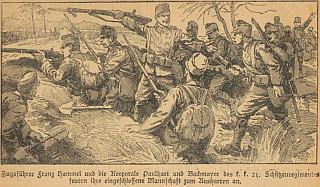
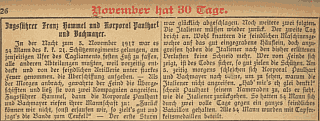

,Jänner 1918
Hammel was a squad commander from the k.k. Schützenregiment Nr. 21 depicted on a propaganda poster that Švejk observed at Tábor railway station. Together with Korporal Paulhart and Korporal Bachmayer he urged the men to persevere.
Background
Hammel had exactly the rank and regiment affiliation that Hašek described in the novel. He was a k.k. Landwehr Zugsführer and fought with k.k. Schützenregiment Nr. 21 on the Italian front in 1917. There is no doubt that Hašek borrowed the motif from Kriegskalender 1919 because the descriptions in The Good Soldier Švejk and the calendar are identical to the letter. It has however not been possible to trace Hammel further, probably due to a mis-spelling of his name in the calendar. What his real surname is we therefore don't know. See Kriegskalender for more on this theme.
Tagliamento, 1917
The events that were described on the posters that Švejk observed in Tábor in early 1915 actually took place, but almost three years later. Hammel, Korporal Paulhart and Korporal Bachmayer all served in k.k. Schützenregiment Nr. 21 and they were mentioned together in a battlefield report in early 1918. The title was Das St. Pöltner Schützenregiment Nr. 21 am Tagliamento and it was printed in Streffleur's Militärblatt, Linzer Volkszeitung a.o. It dealt with the regiment's engagement by the river Tagliamento in northern Italy on 5 November 1917, and includes a few lines about the three soldiers who are mentioned in The Good Soldier Švejk. All three distinguished themselves during the battle and were awarded silver medals for bravery.
Korporal Paulhart and Korporal Bachmayer have been identified and information about them confirmed by their Belohnungsantrag whereas the identity of Hammel remains unclear (probably due to a misspelling of his surname).
Quote(s) from the novel
[II.1] Dobrého vojáka Švejka uvítal obraz znázorňující dle nápisu, jak četař František Hammel a desátníci Paulhart a Bachmayer od c. k. 21. střeleckého pluku povzbuzují mužstvo k vytrvání. Na druhé straně visel obraz s nadpisem: „Četař Jan Danko od 5. pluku honvédských husarů vypátrá stanoviště nepřátelské baterie.“
Literature
 | Korporal Paulhart, Josef |  | ||||
| *27.2.1892 Alt-Lichtenwörth - †? | ||||||
| ||||||

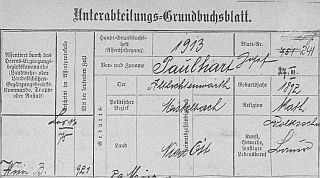

,Jänner 1918
Paulhart was depicted on a propaganda poster that Švejk observed in the military part of Tábor railway station. On the same poster were also shown Zugsführer Hammel and Korporal Bachmayer. All three served with k.k. Schützenregiment Nr. 21.
Background
Paulhart had exactly the rank and unit affiliation that Hašek described in the novel: he was a Korporal in k.k. Landwehr and served with k.k. Schützenregiment Nr. 21.
Josef Paulhart's Grundbuchsblatt[a] (service record) reveals that he was born 27 February 1892 in Altlichtenwarth, Bezirk Mistelbach, and was a farmer by profession. He started his military service on 1 October 1913 when he was assigned to k.k. Landwehrinfanterieregiment Nr. 24 (Vienna), then transferred to k.k. Landwehrinfanterieregiment Nr. 2 (Linz) on the 16th. For some reason he was transferred again 13 December 1913, now to k.k. Schützenregiment Nr. 21 where he served for the duration of the war. In August 1917 he was hospitalised and by then he had been promoted to Gefreiter titulär Korporal and was decorated with a Karl-Truppen-Kreuz. On 12 November he was proposed for a silver medal 1st class. On 3 November 1918 he was taken prisoner by the Italians by Tagliamento, then released and demobilised in 1919. The service record further reveals that he was 164 cm tall, had black hair, blue eyes, spoke only German etc. See Kriegskalender for more on this theme.
Tagliamento, 1917
The events that were described on the posters that Švejk observed in Tábor in early 1915 actually took place, but almost three years later. Zugsführer Hammel, Paulhart and Korporal Bachmayer all served in k.k. Schützenregiment Nr. 21 and they were mentioned together in a battlefield report in early 1918. The title was Das St. Pöltner Schützenregiment Nr. 21 am Tagliamento and it was printed in Streffleur's Militärblatt, Linzer Volkszeitung a.o. It dealt with the regiment's engagement by the river Tagliamento in northern Italy on 5 November 1917, and includes a few lines about the three soldiers who are mentioned in The Good Soldier Švejk. All three distinguished themselves during the battle and were awarded silver medals for bravery.
Paulhart and Korporal Bachmayer have been identified and information about them confirmed by their Belohnungsantrag whereas the identity of Zugsführer Hammel remains unclear (probably due to a misspelling of his surname).
Quote(s) from the novel
[II.1] Dobrého vojáka Švejka uvítal obraz znázorňující dle nápisu, jak četař František Hammel a desátníci Paulhart a Bachmayer od c. k. 21. střeleckého pluku povzbuzují mužstvo k vytrvání. Na druhé straně visel obraz s nadpisem: „Četař Jan Danko od 5. pluku honvédských husarů vypátrá stanoviště nepřátelské baterie.“
Literature
- Das St. Pöltner Schützenregiment Nr. 21 am Tagliamento, ,12.1.1918
- Das St. Pöltner Schützenregiment Nr. 21 am Tagliamento, ,24.2.1918
- Unterabteilungs-Grundbuchsblatt, [a]
| a | Unterabteilungs-Grundbuchsblatt |
 | Korporal Bachmayer, Franz |  | ||||
| *1897 Eggenburg - †? | ||||||
| ||||||

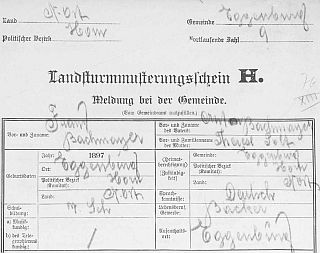
Landsturmmusterungsschein, Franz Bachmayer

,Jänner 1918
Bachmayer was depicted on a propaganda poster at Tábor railway station, mentioned in the same breath as Zugsführer Hammel and Korporal Paulhart. Like the other two he served with k.k. Schützenregiment Nr. 21.
Background
Bachmayer had exactly the rank and unit affiliation that Hašek described in the novel. He was a k.k. Landwehr Korporal and served with k.k. Schützenregiment Nr. 21 on the Italian front together with Zugsführer Hammel and Korporal Paulhart. At the end of 1917 he was awarded the silver medal 1st class for bravery and this was the third time that he was decorated[a]. The reason for his decoration was bravery shown by Tagliamento on 5 November 1917.
Franz Bachmayer was from Eggenburg in Niederösterreich, Bezirk Horn, and was enlisted 5 June 1915 at the age of 18. His profession was baker[b]. Apart from the mentioned exploits by Tagliamento his career during the war and life afterwards remains in the dark. See Kriegskalender for more on this theme.
Tagliamento, 1917
The events that were described on the posters that Švejk observed in Tábor in early 1915 actually took place, but almost three years later. Zugsführer Hammel, Korporal Paulhart and Bachmayer all served in k.k. Schützenregiment Nr. 21 and they were mentioned together in a battlefield report in early 1918. The title was Das St. Pöltner Schützenregiment Nr. 21 am Tagliamento and it was printed in Streffleur's Militärblatt, Linzer Volkszeitung a.o. It dealt with the regiment's engagement by the river Tagliamento in northern Italy on 5 November 1917, and includes a few lines about the three soldiers who are mentioned in The Good Soldier Švejk. All three distinguished themselves during the battle and were awarded silver medals for bravery.
Korporal Paulhart and Bachmayer have been identified and information about them confirmed by their Belohnungsantrag whereas the identity of Zugsführer Hammel remains unclear (probably due to a misspelling of his surname).
Quote(s) from the novel
[II.1] Dobrého vojáka Švejka uvítal obraz znázorňující dle nápisu, jak četař František Hammel a desátníci Paulhart a Bachmayer od c. k. 21. střeleckého pluku povzbuzují mužstvo k vytrvání. Na druhé straně visel obraz s nadpisem: „Četař Jan Danko od 5. pluku honvédských husarů vypátrá stanoviště nepřátelské baterie.“
Literature
- Das St. Pöltner Schützenregiment Nr. 21 am Tagliamento, ,12.1.1918
- Das St. Pöltner Schützenregiment Nr. 21 am Tagliamento, ,24.2.1918
- Auszeichnungen, ,15.2.1918 [a]
- Landsturmmusterungschein, [b]
| a | Auszeichnungen | 15.2.1918 | |
| b | Landsturmmusterungschein |
 | Zugsführer Danko, Jan |  | ||||
| ||||||
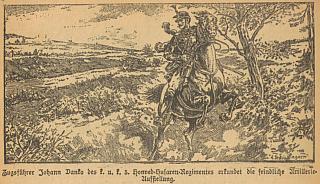
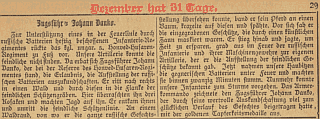

Oesterreichische Volks-Zeitung, 21.10.1914
Danko was a Zugsführer from k.u. Honvéd Husaren Regiment Nr. 5, depicted on a propaganda placard that Švejk observed at Tábor railway station.
Background
Danko was exactly what the author described him as: Zugsführer in k.u. Honvéd Husaren Regiment Nr. 5. In October 1914 Oesterreichische Volks-Zeitung and others reported that he had been awarded the gold medal for bravery. The report in the paper was from the propaganda series Aus dem Goldenen Buche der Armee and was near identical to the description in The Good Soldier Švejk [a].
Dankó János szakaszvezető

A volt m. kir. kassai 5. honvéd huszárezred története 1868-1918, 1935.
In 1935 the regiment's history was published as a book and provides further information[b]. The soldier's name was Dankó János (in Hungarian family names are written first) and his rank is confirmed as Szakaszvezető (Zugsführer). He had been promoted after the battles by Dzibułki (ukr. Зіболки) north-east of Lemberg at the end of August 1914. On 2 October 1914, he was awarded a gold medal for bravery, exactly as the abovementioned Austrian newspaper reported a few weeks later. See Kriegskalender for more on this theme.
A volt m. kir. kassai 5. honvéd huszárezred története 1868-1918 (Regiment history, 1935)
Dankó János 1. századbeli tizedest üzibulkinál tanúsított kiválóan vitéz magatartásáért szakaszvezetővé léptették elő...
A Dzibulkinál vívott harcokban tanúsított vitéz magatartásáért Dankó János szakaszvezető arany vitézségi érmet...
Quote(s) from the novel
[II.1] Na druhé straně visel obraz s nadpisem: „Četař Jan Danko od 5. pluku honvédských husarů vypátrá stanoviště nepřátelské baterie.“
Literature
- Aus dem goldenen Buch der Armee, ,20.10.1914 [a]
- A volt m. kir. kassai 5. honvéd huszárezred története 1868-1918, ,1935 [b]
| a | Aus dem goldenen Buch der Armee | 20.10.1914 | |
| b | A volt m. kir. kassai 5. honvéd huszárezred története 1868-1918 | 1935 |
 | Trainsoldat Bong, Josef |  | ||||
| ||||||
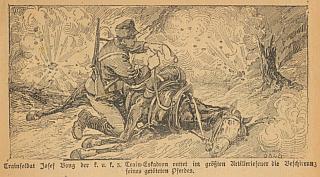


, 5.12.1914

, 19.2.1915
Bong is mentioned 3 times in The Good Soldier Švejk.
Bong was a soldier in k.u.k. Traineskadron Nr. 3 who was described in praising terms on a propaganda poster at Tábor station. He had saved the valuable harness of his dead horse, despite being fired at by Russian artillery. He was subsequently awarded a silver medal for bravery.
Background
Bong was a real person and what the author reproduces is merely a more colourful variation of news items that appeared in the press in January and February 1915. All had the title Aus dem Goldenen Buche der Armee, a series that was published regularly. It informed of various heroic deeds and some where also available as postcards, and surely also as posters.
News about Bong having been awarded the silver medal 2nd class had been reported in newspapers in early December, based on Verordnungsblatt für das k.u.k. Heer from 5 December 1914. Here the soldier's unit is confirmed: k.u.k. Traineskadron Nr. 3, Traindivision Nr. 1. At the time of his decoration he served with Divisions-Sanitätsanstalt Nr. 12. Given the regiment's recruitment district was Kraków (it included parts of Moravia and Silesia) his nationality was most likely Polish or Czech.
Despite the various news items there is little doubt that Hašek's source was Kriegskalender for 1919, or rather the Czech version of it. The entire text segment describing Bong is, apart from the colour of the horse and a couple of minor differences, word by word identical to the text in the calendar.
Quote(s) from the novel
[II.1] Zatímco šikovatel šel shánět nějakého důstojníka, Švejk si přečetl na plakátu:
VOZATAJEC JOSEF BONG
Vojáci zdravotního sboru dopravovali těžce raněné k vozům, připraveným v kryté úžlabině. Jakmile byl plný, odjelo se s ním na obvaziště. Rusové, vypátravše tyto vozy, počali je obstřelovati granáty. Kůň vozatajce Josefa Bonga od c. a k. 3. vozatajské švadrony byl usmrcen střepinou granátu. Bong bědoval: „Ubohý můj bělouši, je veta po tobě!“ Vtom sám zasažen byl kusem granátu. Přesto vypřáhnul svého koně a odtáhl trojspřeží za bezpečný úkryt. Nato se vrátil pro postroj svého usmrceného koně. Rusové stříleli stále. „Jen si střílejte, zpropadení zuřivci, já postroj tady nenechám!“ a snímal dál postroj s koně, bruče si ona slova. Konečně byl hotov a vláčel se s postrojem zpět k vozu. Zde mu bylo vyslechnouti hromobití od zdravotních vojínů pro jeho dlouhou nepřítomnost. „Nechtěl jsem tam nechat postroj, je skoro nový. Bylo by ho škoda, pomyslil jsem si. Nemáme nazbyt takových věcí,“ omlouval se statečný vojín, odjížděje k obvazišti, kde se teprve hlásil jako raněný. Jeho rytmistr ozdobil později prsa jeho stříbrnou medalií za statečnost.
Literature
- Verordnungen des k.u.k. Kriegsministeriums, ,6.12.1914
- Tapfere Soldaten, ,21.1.1915
- Ehrenbuch der Österreichisch-Ungarischen Wehrmacht, ,1917
 | Doctor Vojna, Josef |  | ||||
| ||||||

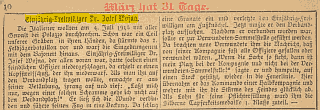
Vojna was a one-year volunteer from Feldjägerbataillon Nr. 7 who fought in Galicia. He is mentioned in an anecdote by Švejk at Táborské nádraží about an example of courage that surpassed even that of Trainsoldat Bong. Švejk had read a story in Pražské úřední listy that could reveal that the head of Vojna had extorted great deeds even after it was blown off.
Background
Vojna is one of the heroes that the author picked from Kriegskalender 1919 together with Zugsführer Danko, Trainsoldat Bong, Zugsführer Hammel a.o. Švejk however exaggerated wildly as Vojna according to the calendar was injured twice and despite his injuries assumed control of a half company. There is however no mention of his hand or head being blown off.
According to the calendar the heroic deed took place by Polazzo on 4 July 1915 and not in Galicia as Švejk claimed. It is also informed that Vojna was decorated with a silver medal 1st class for his heroics. The date also makes it obvious that Švejk could not have read about Vojna before reaching Tábor as Italy only entered the war when Švejk's march company had arrived in Budapest (23 May).
Dr. Josef Wojnar
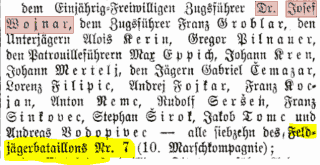
,14.10.1915
No Josef Vojna from Feldjägerbataillon Nr. 7 figures in Austro-Hungarian casualty lists, in lists of decorated soldiers, or in Verordnungsblatt or Ranglisten. Nor does a search for the surname "Wojna" as given in the calendar yield any results. The reason is simply a typing error in Kriegskalender because his name was actually Josef Wojnar[b]. News of him being awarded a silver medal for bravery was reported in several newspapers and in Wiener Zeitung on 14 October 1915 he is clearly identified as Dr. Josef Wojnar from Feldjägerbataillon Nr. 7, albeit with a silver medal 2nd class instead of 1st class as the calendar states. In 1918 the Viennese newspaper Weltblatt confirmed most of the information from the war calendar[c].
Newspaper snippets and army publications enable us to assembly some details from his military career. He had his left large toe bruised/crushed late 1914 or early in 1915 by Hroscienko (probably Krościenko) and was hospitalised in reserve hospital in Klagenfurt. At the time his rank was Einjährig-Freiwilliger Unterjäger (i.e. one-year volunteer infantryman) and he served in the 3rd company. His birth year is given as 1890[d] and this must have happened at the front in the Carpathians because the war with Italy had not yet started. Wojnar decorated 5 times. , 1918
By 4 July 1915 he had returned to front service with the 10th March Company and had by now been promoted to Zugsführer. He was involved in the 1st battle of the Isonzo by Polazzo that day. He was first knocked unconscious by a grazing shot to his head but returned to his position only to have his foot bruised by debris after a shell hit the trench. Still he insisted to remain on duty[c].
Ranglisten reveal that he was quickly promoted. On 1 January 1916 he was already Leutnant in der Reserve. He was decorated no less than five times during the war[e]. The 7. Feldjägerbataillon was mainly manned by Slovenes (85 per cent) but a one-year volunteer could to a degree choose where to serve. Wojnar is a rare name in Slovenia but is widespread in Poland and in the eastern part of Czech Silesia so his roots were probably in Galicia or Silesia. See Kriegskalender for more on this theme.
Quote(s) from the novel
[II.1] Když Švejk dočetl a šikovatel se ještě nevracel, řekl k landverákům na strážnici: „Tohle je moc krásnej příklad zmužilosti. Takhle budou u nás v armádě samý nový postroje na koně, ale když jsem byl v Praze, tak jsem čet v Pražskejch úředních listech ještě hezčí případ vo nějakým jednoročním dobrovolníkovi Dr Josefu Vojnovi. Ten byl v Haliči u 7. praporu polních myslivců, a když to přišlo na bodáky, tak dostal kulku do hlavy, a když ho vodnášeli na obvaziště, tak na ně zařval, že kvůli takovému šrámu se nenechá obvázat. A zas chtěl hned se svou četou forikovat, ale granát mu usekl kotník. Zas ho chtěli vodnášet, ale von se počal belhat vo holi k bitevní čáře a holí se bránil proti nepříteli, a přilít novej granát a utrh mu tu ruku, ve kterej držel hůl. Von si tu hůl přendal do druhý ruky, zařval, že jim to nevodpustí, a bůhví jak by to s ním dopadlo, kdyby ho byl šrapnel za chvilku definitivně nezamordoval. Možná, že kdyby ho nakonec přece jen nevoddělali, že by byl taky dostal stříbrnou medalii za statečnost. Když mu to urazilo hlavu,tak,jak se kutálela, ještě vykřikla: ,Vždy povinnosti věrné spěch, byť vůkol vanul smrti dech!’“
Literature
- Kriegs-Kalender des Fremden-Blatt, ,1915 [a]
- Die silberne Tapferkeitsmedaille zweiter Klasse, ,14.10.1915 [b]
- Die Jäger sind schon vorne..., ,26.9.1918 [c]
- Nachrichten über Verwundete und Kranke, ,7.4.1915 [d]
- Ranglisten des Kaiserlich und Königlichen Heeres (s. 845), ,1918 [e]
 | Shoemaker Petrlík |  | ||||
| ||||||
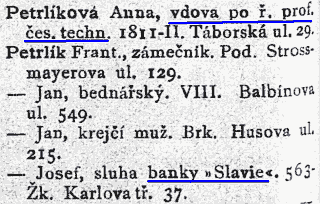
, 1910
Petrlík is a deceased shoemaker mentioned by Švejk when he tries, in his long-winded way, to explain the lieutenant at the railway station in Tábor why he missed his train.
Background
In the Prague address books from 1907 and 1910 several Petrlík are listed but none of them were shoemakers. Hašek may well have known or known about a couple fo them. A certain Josef Petrlík was employed by Banka Slavia where Hašek worked for a short period in 1902 and 1903.
Kristián Petrlík (1842-1908) was professor at the technical college at Karlovo náměstí where the author had many aquaintances. The latter died 31 March 1908 so could it be that Hašek "degraded" the venerable professor to a shoemaker? Still it could hardly be much more that borrowing the name.
Salát-Petrlík
Petrlík is even a name the author may have borrowed from Jaroslav Salát-Petrlík who worked for the Czech social democrats (communists) in Moscow at the time Hašek returned from Russia in 1920. His original name was Petrlík. 17 September 1920 Hašek sent him a letter where he summarized his activities in Russia from 1918 onwards, more or less a CV underpinning his Communist credentials. The original letter has not been found, leading to speculation that the letter may be fake. Jan Berwid-Buquoy is the prime propagator of this theory, and he mentions the letter in both his books about Hašek. In 1983 the debate even reached the columns of the Communist Party mouthpiece Rudé Pravo.
Dokument československého parlamentu, 15.5.1921
Za nimi pak jel 11. října 1920 nynější vůdce československé kolonie v Moskvě, známý Salát-Petrlík, který byl určen, aby osobně řídil revoluční akci. Po nezdařeném pokusu se pak Salát opět vrátil do Moskvy, kamž přibyl 17. ledna 1920.
Quote(s) from the novel
[II.1] „Poslušně hlásím, pane lajtnant, že vono je třeba, aby to lezlo ze mě jako z chlupatý deky, aby byl přehled vo celý události, jak to vždycky říkal nebožtík švec Petrlík, když poroučel svýmu klukovi, než ho začal řezat řemenem, aby si svlíkl kalhoty.“
Credit: Radko Pytlík, Jan Berwid-Buquoy
Literature
- Stenoprotokol, 73. schůze, 15.7.1921,
- Prof Petrlík ✝, ,31.3.1908
 | Korporal Palánek |  | |||
| |||||
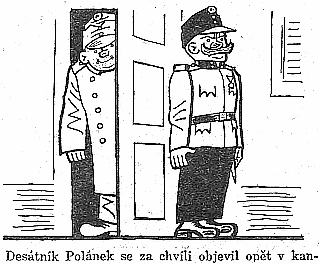
,27.1.1924
Palánek was at the station i Tábor given the task to get Švejk a ticket onwards to Budějovice. He didn't have any money so his superior decided that Švejk had to continue on foot. To judge by previous passages in the plot Palánek served with k.k. Landwehr.
Background
Quests to find any prototype or source of inspiration for this Korporal have not succeeded. Palánek is a relatively rare surname.
Quote(s) from the novel
[II.1] Poněvadž se Švejk nehýbal a stále držel ruku na štítku čepice, poručík zařval: „Marsch hinaus, neslyšel jste, abtreten? Korporál Palánek, vezměte toho chlapa blbého ke kase a kupte mu lístek do Českých Budějovic!“ Desátník Palánek se za chvíli objevil opět v kanceláři. Pootevřenými dveřmi nakukovala za Palánkem dobromyslná tvář Švejkova.
 | Solomon |  | |||
| *? - †931 BC Jerusalem | |||||
| |||||

The Judgement of Solomon by Gaspar de Crayer (appx. 1620)
Solomon is mentioned by the author when he describes the drastic decision of the Leutnant at Táborské nádraží to let Švejk walk to Budějovice. He uses the expressions "Solomonic solution".
Background
Solomon was king of Judea in the Old Testament, the son of David. He was famed for his wisdom. Whether or not he existed is under debate.
A Solomonic Judgement is a fair and wise solution to a difficult problem. The saying is based upon the Biblical passage in 1 Kings 3:16-28, where king Solomon resolves a disagreement between two mothers about a child which both claimed was hers.
Quote(s) from the novel
[II.1] Poručík dlouho nedal na sebe čekat se šalomounským rozřešením trudné otázky. „Tak ať jde pěšky,“ rozhodl, „ať ho zavřou u pluku, že se opozdil; kdo se s ním tady bude tahat.“
Also written:ŠalomounczSalomode



|
II. At the front |
 | |
1. Švejk's mishaps on the train | |||
| © 2008 - 2024 Jomar Hønsi | Last updated: 20.11.2024 |


